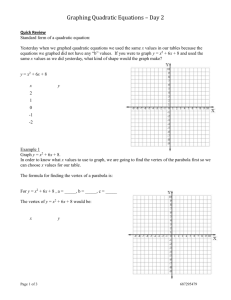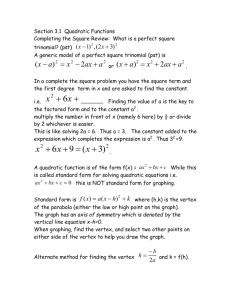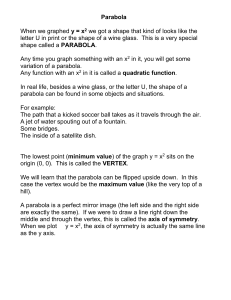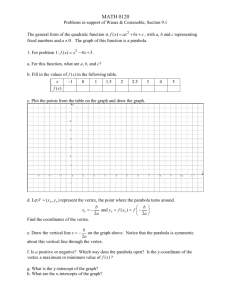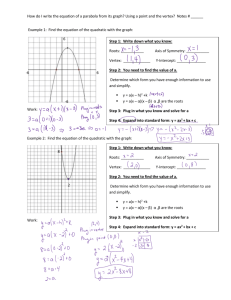Quadratic Functions Vocabulary f(x) = a(x
advertisement
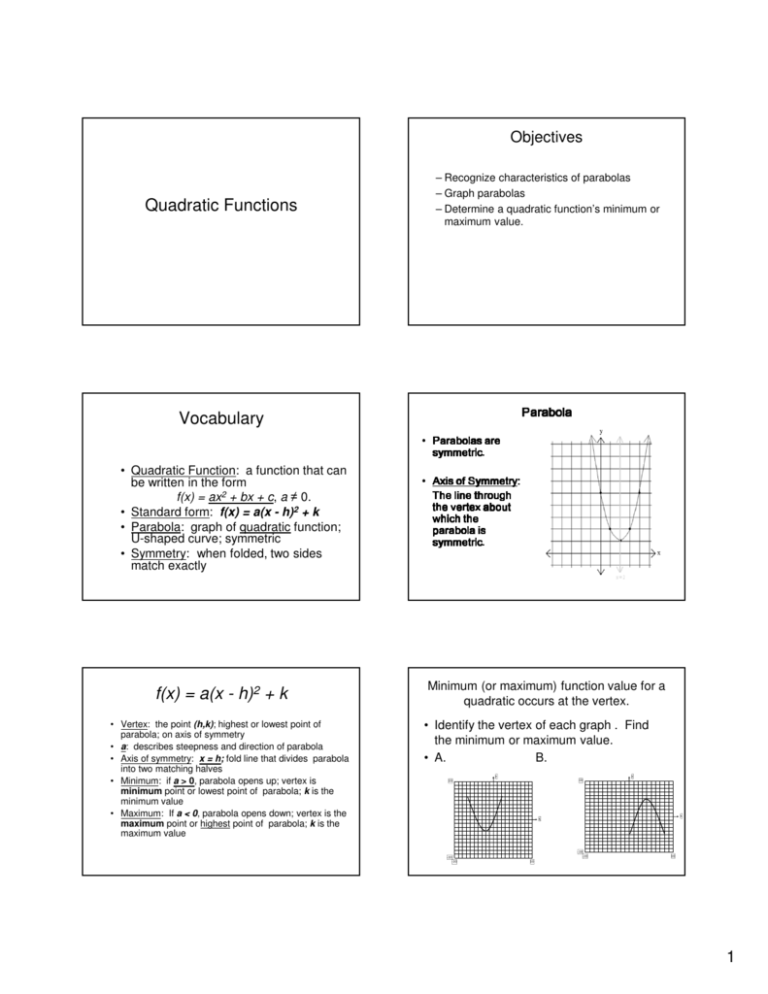
Objectives – Recognize characteristics of parabolas – Graph parabolas – Determine a quadratic function’s minimum or maximum value. Quadratic Functions Parabola Vocabulary • • Quadratic Function: a function that can be written in the form f(x) = ax2 + bx + c, a ≠ 0. • Standard form: f(x) = a(x - h)2 + k • Parabola: graph of quadratic function; U-shaped curve; symmetric • Symmetry: when folded, two sides match exactly f(x) = a(x - h)2 + k • Vertex: the point (h,k); highest or lowest point of parabola; on axis of symmetry • a: describes steepness and direction of parabola • Axis of symmetry: x = h; fold line that divides parabola into two matching halves • Minimum: if a > 0, parabola opens up; vertex is minimum point or lowest point of parabola; k is the minimum value • Maximum: If a < 0, parabola opens down; vertex is the maximum point or highest point of parabola; k is the maximum value • Parabolas are symmetric. Axis of Symmetry: Symmetry: The line through the vertex about which the parabola is symmetric. Minimum (or maximum) function value for a quadratic occurs at the vertex. • Identify the vertex of each graph . Find the minimum or maximum value. • A. B. y y 10 10 x x -10 -10 -10 -10 10 10 1 Example • Determine the following for f(x) without graphing. • f(x) = -3(x – 2)² + 12 Finding the vertex when in ax2 + bx + c form. Vertex = a.) Find the vertex. b.) Find the equation of the axis of symmetry. c.) Does f(x) open up or down? d.) Does f(x) have a max. or min. value? Where does this value occur? e.) What is the domain of f(x)? f.) What is the range of f(x)? Example • Determine the following for f(x) without graphing. • f(x) = 2x² - 8 x - 3 a.) Find the vertex. b.) Find the equation of the axis of symmetry. c.) Does f(x) open up or down? d.) Does f(x) have a max. or min. value? Where does this value occur? e.) What is the domain of f(x)? f.) What is the range of f(x)? If no “B” term, use square root property to solve for zeros. Review:Solving Quadratic Equations (So you can find the x-intercepts!!) Example: Get in standard form. Factor. 3x2 – 2x = 21 3x2 – 2x – 21 = 0 (3x + 7)(x – 3) = 0 Set each factor equal to zero. 3x+7=0 or x–3 = 0 Solve. Check. x = -7/3 or x = 3 When factoring or square root property won’t work, you can always use the QUADRATIC FORMULA For example, if x2 = 16, then x = ±4. • Solve f(x) = 1 – (x – 3)2. • • • • Get in standard form: ax2 + bx + c = 0 Substitute for a, b, and c in formula. Solve. Check. This works every time!!! 2 Solve using the Quadratic formula. x2 + 2x = -3 To Graph a Quadratic Function 1. Find the coordinates of the vertex. (Use the vertex formula, if necessary.) 2. Determine which way parabola opens by looking at a. a > 0 parabola opens up (Vertex is lowest point) a < 0 parabola opens down (Vertex is highest point) 3. Find the xx-intercept(s). (Set y = 0) 4. Find the yy-intercept. (Set x = 0) 5. Graph additional points if needed by tt-chart or symmetry. Example Example • Graph f(x) = (x – 2)2 + 1. • Graph f(x) = -(x – 1)2 + 4. y 10 y 10 x x -10 -10 -10 -10 Use the vertex and intercepts to graph f(x) = 5 – 4x – x² Give the equation of the axis of symmetry. 10 10 Re-Cap Quadratic Equations & Functions Determine the domain and range of f(x). ax2 + bx + c = 0 or f(x) = ax2 + bx + c, • “x” is squared. • Graph would be a curve. • Solutions are at the x-intercepts. The “zeros” are the solutions or roots of the equation. • To solve: factor & use zero product property, take square root of both sides (if no B term), or use other methods. 3 Example f(x) = 4x2 - 16x + 1000 a) Determine, without graphing, whether the function has a minimum value or a maximum value. b) Find the minimum or maximum value and determine where it occurs. c) Identify the function’s domain and range. 4


